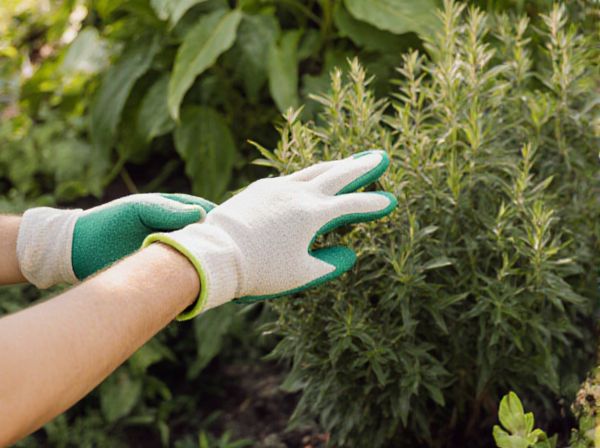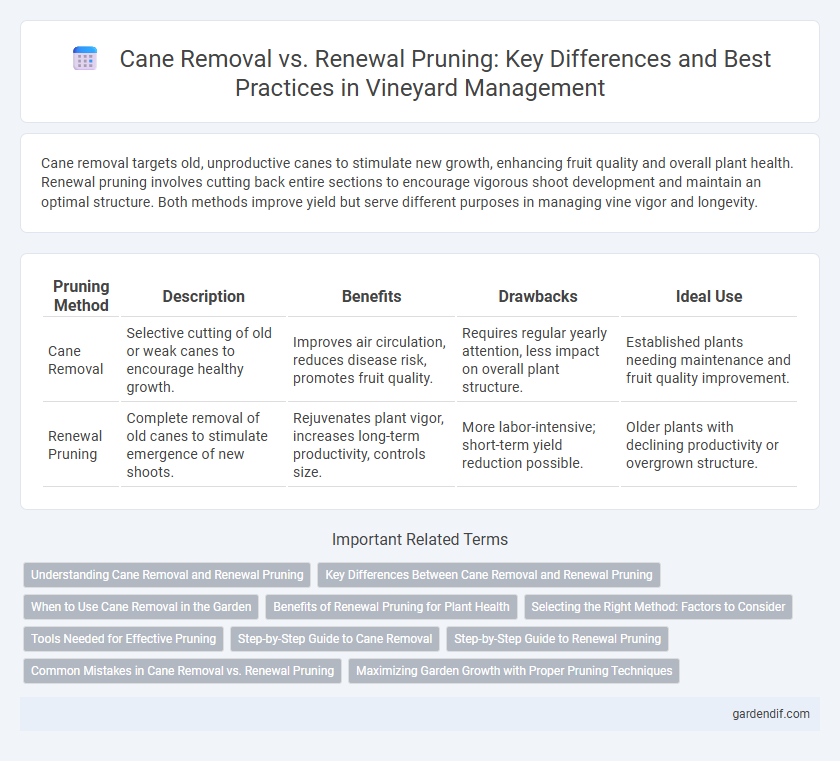
Cane removal vs renewal pruning Illustration
Cane removal targets old, unproductive canes to stimulate new growth, enhancing fruit quality and overall plant health. Renewal pruning involves cutting back entire sections to encourage vigorous shoot development and maintain an optimal structure. Both methods improve yield but serve different purposes in managing vine vigor and longevity.
Table of Comparison
| Pruning Method | Description | Benefits | Drawbacks | Ideal Use |
|---|---|---|---|---|
| Cane Removal | Selective cutting of old or weak canes to encourage healthy growth. | Improves air circulation, reduces disease risk, promotes fruit quality. | Requires regular yearly attention, less impact on overall plant structure. | Established plants needing maintenance and fruit quality improvement. |
| Renewal Pruning | Complete removal of old canes to stimulate emergence of new shoots. | Rejuvenates plant vigor, increases long-term productivity, controls size. | More labor-intensive; short-term yield reduction possible. | Older plants with declining productivity or overgrown structure. |
Understanding Cane Removal and Renewal Pruning
Cane removal targets the elimination of older, less productive canes to encourage healthier growth, enhancing fruit quality and yield. Renewal pruning involves cutting back to stimulate the growth of new canes from the base, ensuring the longevity and vigor of the plant. Understanding these techniques optimizes vineyard management and promotes sustainable cane structure maintenance.
Key Differences Between Cane Removal and Renewal Pruning
Cane removal targets the elimination of old or unproductive canes to improve air circulation and light penetration, promoting healthier growth. Renewal pruning involves cutting back entire sections or canes to stimulate the production of new, vigorous shoots for sustained plant vitality. The key difference lies in cane removal focusing on selective cutting, while renewal pruning emphasizes rejuvenating the plant by encouraging fresh growth.
When to Use Cane Removal in the Garden
Cane removal is best used in early spring before new growth begins, targeting old, weak, or overcrowded canes to improve air circulation and light penetration. This method enhances plant health and fruit production by encouraging vigorous new growth and reducing disease risk. Gardeners should apply cane removal selectively when canes show signs of aging or damage rather than performing a full renewal pruning.
Benefits of Renewal Pruning for Plant Health
Renewal pruning stimulates vigorous new growth by removing old, unproductive canes, enhancing air circulation and sunlight penetration within the plant canopy. This method reduces the risk of disease and pest infestations by eliminating decayed or weak wood, thereby improving overall plant vitality. Healthier plants resulting from renewal pruning exhibit increased fruit yield and quality, supporting long-term landscape sustainability.
Selecting the Right Method: Factors to Consider
Selecting the right pruning method depends on the plant species, age, and overall health, with cane removal best suited for managing fruit-bearing canes in grapevines and blackberries, while renewal pruning targets woody plants requiring rejuvenation. Seasonal timing, growth patterns, and desired yield significantly influence the choice, where cane removal promotes immediate fruit production and renewal pruning encourages long-term vitality. Understanding specific crop requirements and growth cycles ensures effective pruning, enhancing plant productivity and longevity.
Tools Needed for Effective Pruning
Effective cane removal requires tools such as bypass pruners for precise cuts and loppers capable of handling thicker canes up to 1 inch in diameter. Renewal pruning demands sturdier equipment including pruning saws for severing older, woody canes and sharp garden knives to cleanly remove canes at the base. Ensuring tools are sharp, clean, and rust-free enhances cut quality and reduces plant stress, promoting healthier regrowth.
Step-by-Step Guide to Cane Removal
Cane removal involves selectively cutting out old or unproductive canes at the base to promote healthier growth and higher fruit yield in the next season. Begin by identifying and removing canes that are more than two years old, damaged, or weak, using sharp, sterile pruning shears to make clean cuts close to the ground. Proper cleanup of pruned material prevents disease and encourages the development of vigorous new canes for renewal pruning.
Step-by-Step Guide to Renewal Pruning
Renewal pruning involves systematically removing older canes to stimulate vigorous new growth and enhance fruit production in plants like raspberries and blackberries. Begin by identifying and cutting out the oldest, unproductive canes at the base, ensuring to leave the healthiest, youngest canes intact for future growth. Follow this by trimming the remaining canes to promote lateral branching, which supports higher yields and maintains plant structure.
Common Mistakes in Cane Removal vs. Renewal Pruning
Common mistakes in cane removal involve cutting too close to the main stem, which can damage the plant's vascular system and reduce fruit production. Renewal pruning errors often include removing too many old canes at once, resulting in decreased overall yield and weakened plant structure. Proper identification of old versus new canes is crucial to avoid harming the plant's ability to regenerate and produce quality fruit.
Maximizing Garden Growth with Proper Pruning Techniques
Cane removal targets old, unproductive branches to stimulate new growth, increasing light penetration and air circulation essential for garden vitality. Renewal pruning involves cutting back entire canes to their base, promoting vigorous shoot development and improving overall plant structure. Both techniques maximize garden growth by enhancing photosynthesis efficiency and encouraging healthy, robust foliage.
Cane removal vs renewal pruning Infographic

 gardendif.com
gardendif.com